Despite holding the patents to the only commercially viable large-sized OLED television technology on the market at this time of writing, LG is not resting on its laurels. Not only has the South Korean consumer electronics giant started selling its WRGB OLED panel to other display manufacturers, the company has also been working hard to improve its own OLED TV offerings from one generation to the next, as evidenced by the LG 65EF950V (otherwise marketed in North America as the 65EF9500) 4K Ultra HD model we’re reviewing today.
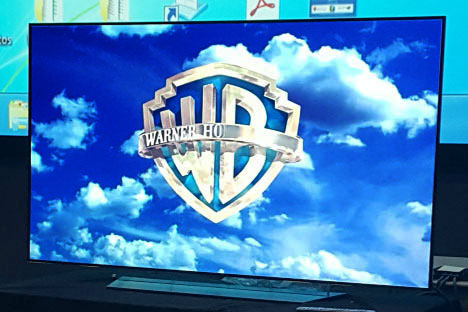
For starters, the EF950V (available as the 55-inch 55EF950V and the 65-inch 65EF950) features a flat-screen design, marking a departure from the curved format which has graced most OLED TVs sold to date. As much as certain TV brands try to extol the virtues of curved displays, it’s exceedingly obvious that video enthusiasts overwhelmingly prefer a flat television, judging from the frenzy over LG’s FLOLED (flat OLED, geddit?) compared with its bendy counterparts (the EG960V and EG920V).
Of course, on paper the LG EF9500 does have another major advantage over the 960V, in that the former is equipped with HDMI 2.0a ports whereas the latter isn’t. This means that the 65EF9500 will be able to detect the HDR (high dynamic range) metadata and apply the necessary PQ EOTF (perceptual quantizer electro-optical transfer function) over HDMI when Ultra HD Blu-ray eventually arrives. However, the EG960 (and the EF950, naturally) can still read and display HDR-treated content via USB and streaming (e.g. from Amazon Prime Video and later Netflix 4K), so owners won’t be totally left out.
Calibrating the EF950V wasn’t as finicky as what we’ve found on previous LG OLEDs – clearly the Korean firm has been doing some work on this front too. Using a Klein K10-A profiled to a JETI 1211 reference-grade spectroradiometer, a DVDO AVLab TPG signal generator and CalMAN Ultimate software, we tuned our LG 65EF950V review sample to D65 greyscale, 2.4 gamma and Rec.709 colours.
Note: Depending on which firmware you’re upgrading from, the latest software update may have shifted the correct [Brightness] setting on some EF9500s, potentially laying waste to any calibration work done before the firmware update. If your LG 950 has been professionally calibrated (even if it’s not by ourselves) before December, feel free to get in touch, and we’ll visit you at no charge when we’re next in your area to verify that your calibrated settings are still holding up.
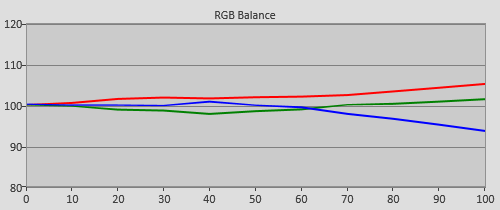 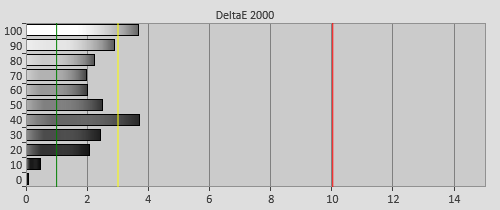 |
| Pre-calibration RGB tracking and delta errors (dEs) |
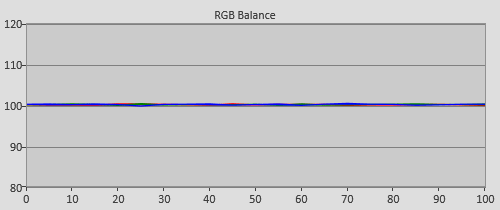 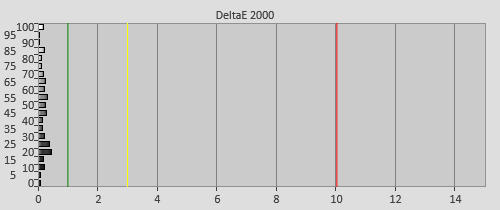 |
| Post-calibration RGB tracking and dEs in [ISF Expert] mode |
![Pre-calibrated Gamma tracking in [ISF Expert] mode](https://www.hdtvtest.co.uk/news/wp-content/uploads/2018/04/uhdtv_LG-65EF950V_pre-gamma.png) | ![Post-calibrated Gamma tracking in [ISF Expert] mode](https://www.hdtvtest.co.uk/news/wp-content/uploads/2018/04/uhdtv_LG-65EF950V_post-gamma.png) |
| Pre-calibration gamma tracking (2.14) | Post-calibration gamma tracking (2.37) |
![Post-calibration Colour saturation tracking in [ISF Expert] mode](https://www.hdtvtest.co.uk/news/wp-content/uploads/2018/04/uhdtv_LG-65EF950V_post-strack.jpg) |
| Post-calibration colour saturation tracking |
![Post-calibration colour errors in [ISF Expert] mode](https://www.hdtvtest.co.uk/news/wp-content/uploads/2018/04/uhdtv_LG-65EF950V_post-strack-de.png) |
| Post-calibration colour errors (<3 not appreciable to the eye) |
| Dead pixels | None |
| Screen uniformity | Vignetting & vertical banding in low APL scenes |
| Overscanning on HDMI | 0% with [Aspect Ratio] set to “Just Scan“ |
| Blacker than black | Passed |
| Calibrated black level (black screen) | 0 cd/m2 |
| Calibrated black level (4×4 ANSI) | 0 cd/m2 |
| Black level retention | Intermittent floating blacks |
| Primary chromaticity | Good, though depends on brightness |
| Scaling | Very good for HD |
| Video mode deinterlacing | Effective jaggies reduction |
| Film mode deinterlacing | Passed 3:2/480i & 2:2/576i cadence tests |
| Viewing angle | Excellent |
| Motion resolution | 650 with [TruMotion] engaged; 300 otherwise |
| Digital noise reduction | Optional; effective when engaged |
| Sharpness | Defeatable edge enhancement |
| Luma/Chroma bandwidth (2D Blu-ray) | Full Luma; Chroma horizontally blurred |
| 1080p/24 capability | No judder in 2D or 3D with correct [TruMotion] settings |
| Measured panel refresh rate | 120Hz |
| Measured DCI-P3 coverage | 86% |
| Leo Bodnar input lag tester | 50ms in [Game] mode |
| Full 4:4:4 reproduction (PC) | Yes for both 1920×1080 and 3840×2160@60Hz |
| Default [Eco] mode | 162 watts |
| Calibrated [ISF Expert] mode | 93 watts |
| Standby | <1 watt |
By now, we’ve tested (and calibrated) our fair share of LG OLED TVs, and are well-versed with its pros and cons. On the whole, the 65EF950V’s picture quality was gobsmackingly good. Its ability to produce absolute blacks and its very wide viewing angles – both afforded by the display technology’s self-illuminating properties – propelled it beyond the reach of any LED LCDs, so much so that most viewers will find it difficult to go back to watching LCD-based displays in a dark room once they’ve experienced the awesomeness of OLED.
| Macro photo confirming LG Display’s RGBW OLED subpixel structure |
The perfect canvas of true blacks also imparted a positive knock-on effect on the LG EF9500’s colour rendition, allowing various shades and hues to explode with a vibrancy that’s enchanting yet reassuringly realistic regardless of the brightness on screen. While LED LCD televisions – particularly full-array local dimming (FALD) sets – have made great strides in recent years, they’ve always had to combat the contaminating effect of the underlying LED light (usually blueish) especially during darker sequences. Being self-emissive, OLED suffers from no such issue, making colour purity easier to achieve.
The area just above black has always been problematic on LG OLEDs, and it’s no exception on the EF950V. On our review unit, there’s some side vignetting in very low-APL scenes, though it’s better than what we’ve seen on the 55EG960V, 55EG920V and especially the 1080p 55EC930V. Thin streaks of vertical banding were also perceptible at specific near-black luminances. These thin lines typically diminished in visibility (but were not completely eradicated) immediately following each OLED compensation cycle, and then gradually built up until the next compensation cycle.
There’s been plenty of confusion over our remark in our 55EG920V review regarding the sub-8-bit near-black handling on LG’s 2015 OLED TVs. To clarify, the OLED panel used is native 10-bit, but judging from our own custom low-level gradient pattern, the display’s near-black gradations are rendered at less than 8-bit precision. This can lead to quantisation errors from 8-bit videos (particularly poorly compressed ones), and explains why LG OLEDs are more prone to exhibiting contouring and noisy artefacts in very dark scenes. In fact, the coarse [Brightness] control out of the box (black level doesn’t change for 2 clicks or more, and then suddenly jumps much brighter as you increase the [Brightness] value) may be a symptom of the lack of granularity near black.
In many other aspects, the LG EF9500 also performed identically to its curved EG920V counterpart. Baseline motion resolution came in at 300 lines (as expected for a sample-and-hold display without the aid of motion-enhancing technologies), going up to 650 lines if [TruMotion] was engaged. Our 65EF950 review unit manifested mild telecine judder with 1080p/24 signal from Blu-ray movies even with [Real Cinema] engaged, but this could be smoothed via specific [TruMotion] “User” values.
Although the Samsung-optimised Life of Pi and Exodus 4K HDR clips appeared washed out with greyish blacks on the 65EF950V possibly owing to application of incorrect PQ EOTF, two demo videos supplied by LG themselves looked exceptional, debunking the misconception that OLED cannot do justice to HDR due to lack of brightness.
Talking of which, the maximum luminance we managed to extract from our EF950V sample was 452 cd/m2 on a windowed pattern, and an ABL-restricted 151 cd/m2 full-field. With [Colour Gamut] set to “Wide“, DCI-P3 coverage was measured to be 86%:
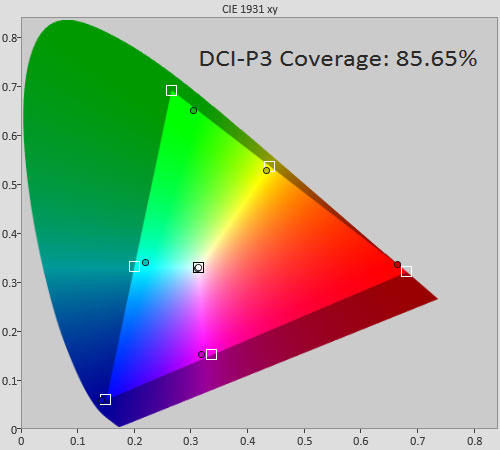
…and 4:4:4 chroma was reproduced at 3840×2160@60Hz if [HDMI Ultra HD Deep Colour] and [PC] mode were both enabled:
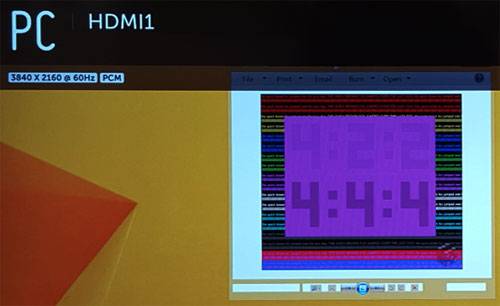
3D was spectacular, thanks to a combination of full HD 3D resolution, zero flicker, bright and colourful images, as well as practically no crosstalk unless you venture 15° vertically beyond eye level. If every 3DTV was blessed with such prowess, then perhaps the format would’ve seen more success in the consumer home environment.

As with all LG 4K OLEDs we’ve reviewed so far, the 65EF950V returned a figure of 50ms in [Game] mode from our Leo Bodnar input lag tester. The [ISF Expert] presets measured 65ms, doubling to 132ms if [TruMotion] was switched on.
Not least due to its flat-screen format, the EF950V is not only LG’s most compelling OLED TV to date, it’s also one of the best televisions we’ve tested all year. While the 65EF950 is not without its flaws especially near-black, for most people they’re far outweighed by the positives… let’s hope 2016 models bring even more improvements.
